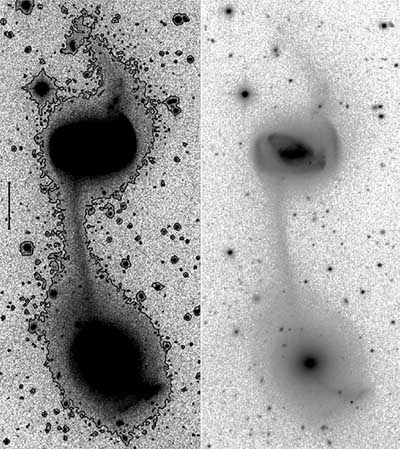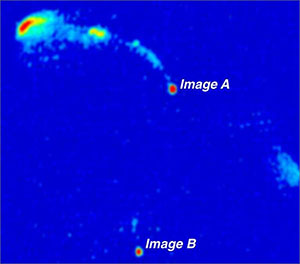ARCHIVE 2016 |
INTRODUCTION |
| Imaging from the worst place on Earth? Possibly!
Welcome to my image blog from Lancashire, UK. Living in Lancashire does make imaging a challenge. Our incessant damp cloudy weather is legendary and coupled with light pollution probably as bright as can be found anywhere (I am 15 miles NW of the centre of Manchester) makes for testing times! Add to that flight path one with constant aeroplanes, which is why it has been suggested as possibly the worst place on Earth for imaging. But there is some good news. With modern light pollution filters we can still produce excellent results - at least when the clouds clear - but of course it's not easy. It would be so much simpler to log onto a robotic rent-a-scope and let them take the image for us. But if you are up for the challenge and the achievement of taking your own images, with your own equipment, in your own back garden, then I hope the following offers some encouragement. Yes it's difficult but we can do it. I shoot the luminance and the colour simultaneously - there are not enough clear spells to allow the luxury of shooting separately. Shooting LRGB with one telescope would take years! So two telescopes and two cameras was the obvious solution . Also necessary is having a dome slot wide enough for both to have a clear line of sight. The luminance is usually taken with the RCOS + Apogee Alta and the colour with the Takahashi + Canon DSLR. Despite their disparate focal lengths this works reasonably well as my current Canon has 4.3 micron pixels (plate scale 2 arcsecs/pixel) and the Apogee 18 micron ones when binned 2x2 (plate scale 1.3 arcsecs/pixel). I find binning essential to maximise signal and improve the signal-to-noise ratio. The images are all taken from my back garden and appear in order of me processing them - we have plenty of cloudy nights for that. I use a combination of IRIS and Maxim for processing with final tweaks in Photoshop. To get rid of the light pollution takes much trial and error. IRIS scores here with several options but processing often comprises many nights work - certainly always longer than the actual taking. The exception are images taken with an h-alpha filter which is a superb light pollution filter. It also permits imaging with strong Moonlight present - isn't it funny how it always seems to be clear at full Moon!
|
|
|
|
18th DECEMBER 2016Galaxies NGC 1 & 2 |
Located just inside the Square of Pegasus, this pair of galaxies mark the first entries in the New General Catalogue (NGC). This "new" catalogue was an update of John Herschel's General Catalogue of Nebulae and Clusters of Stars produce by Dreyer in 1888. The NGC contains 7,840 deep-sky objects. The Catalogue was ordered by RA starting at 0 hr. NGC 1 had an RA in 1860 (the epoch of the 1888 catalogue) of 0hr 0' 04 " and NGC 2 - 0hr 0' 06" - see extract at right. Today however, due to precession NGC 1 now has a RA of 0hr 8' 6" and would no longer come first. Note in Dreyer's Catalogue DEC is measured from the pole - opposite to that we use today. Although NGC 1 is somewhat unspectacular it is really quite a large galaxy similar to the Milky Way but located 220 million light years away. NGC 2 is unrelated and even further distant at around 315 million light years. Image Details
|
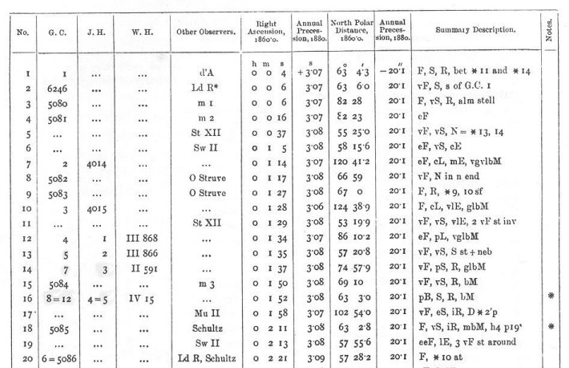 The first 20 entries of Dreyer's New General Catalogue |
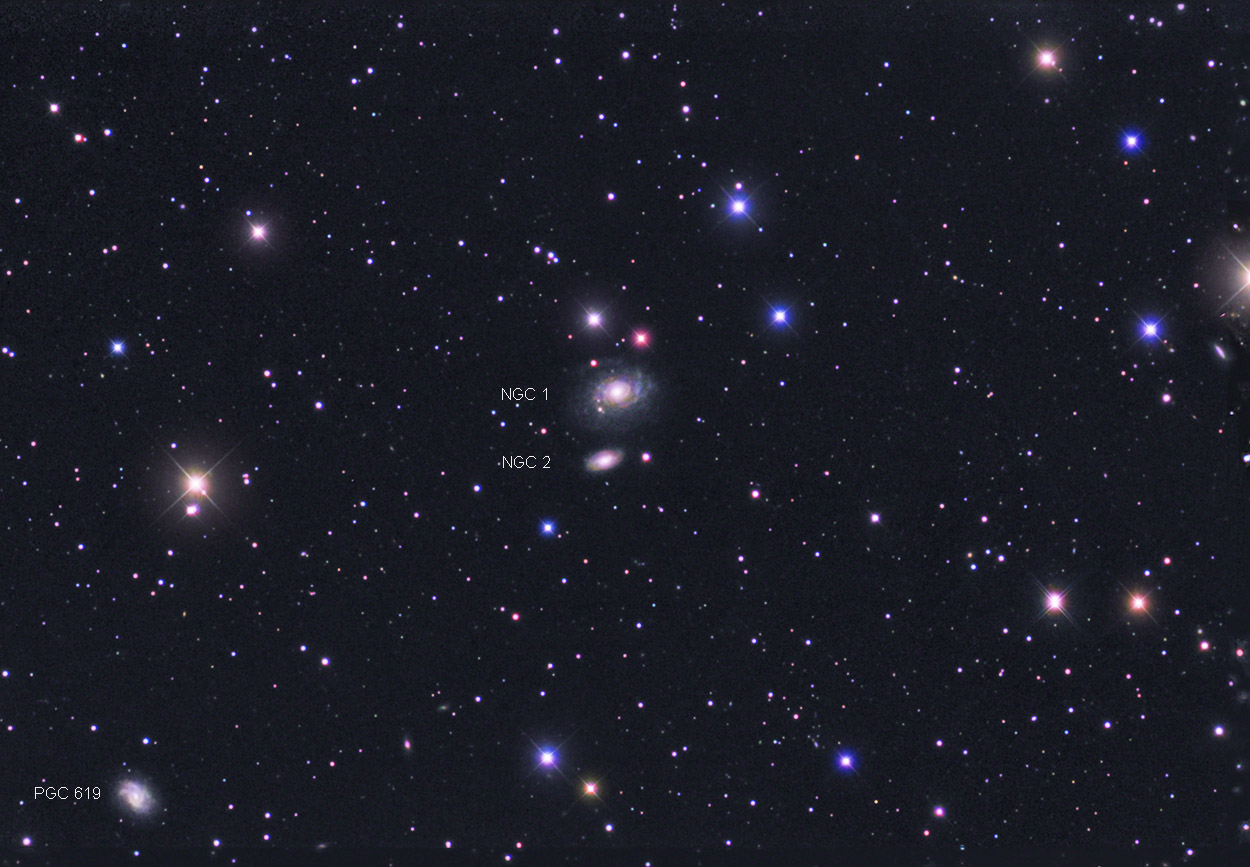 |
Ngc 1 & 2
|
|
4th DECEMBER 2016Stephan's Quintet |
Probably the most famous group of galaxies in the Universe! It was the first compact galaxy group to be discovered by Edouard M. Stephan in 1877. However, it wasn't until the next century when the redshifts of the individual galaxies were measured that it became apparent that all was not as it seemed. The redshift of NGC 7320 was markedly less than the other 4 and so began one of the biggest controversies of 20th century astronomy. Halton Arp and his supporters were convinced redshifts could not be relied upon as distance indicators and cited this group as prime evidence. Today the controversy is largely forgotten and it is accepted that NGC 7320 is not part of the group and is a foreground object. This was reaffirmed by images taken with the Hubble Space Telescope which could resolve stars in NGC 7320 but not the others. The distance to NGC 7320 is around 40 million light years and the group around 290 million light years. NGC 7320C has a redshift matching the group so perhaps it is a quintet after all.
Image Details
|
>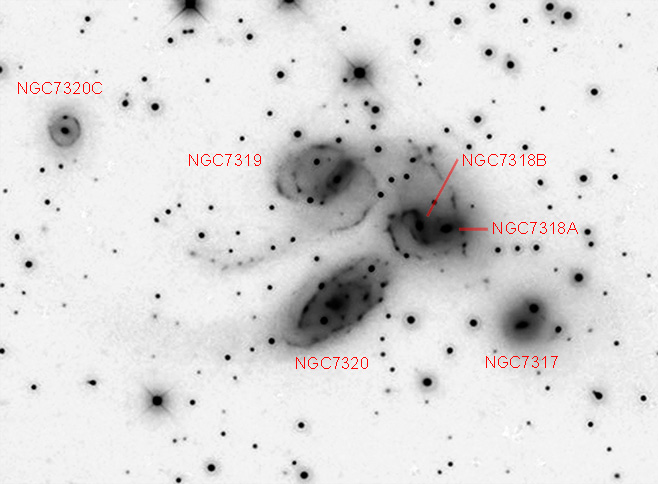 Key to the group members. NGC7320C is not part of Stephan's Quintet but on the basis of redshifts appears to a member of the background group. |
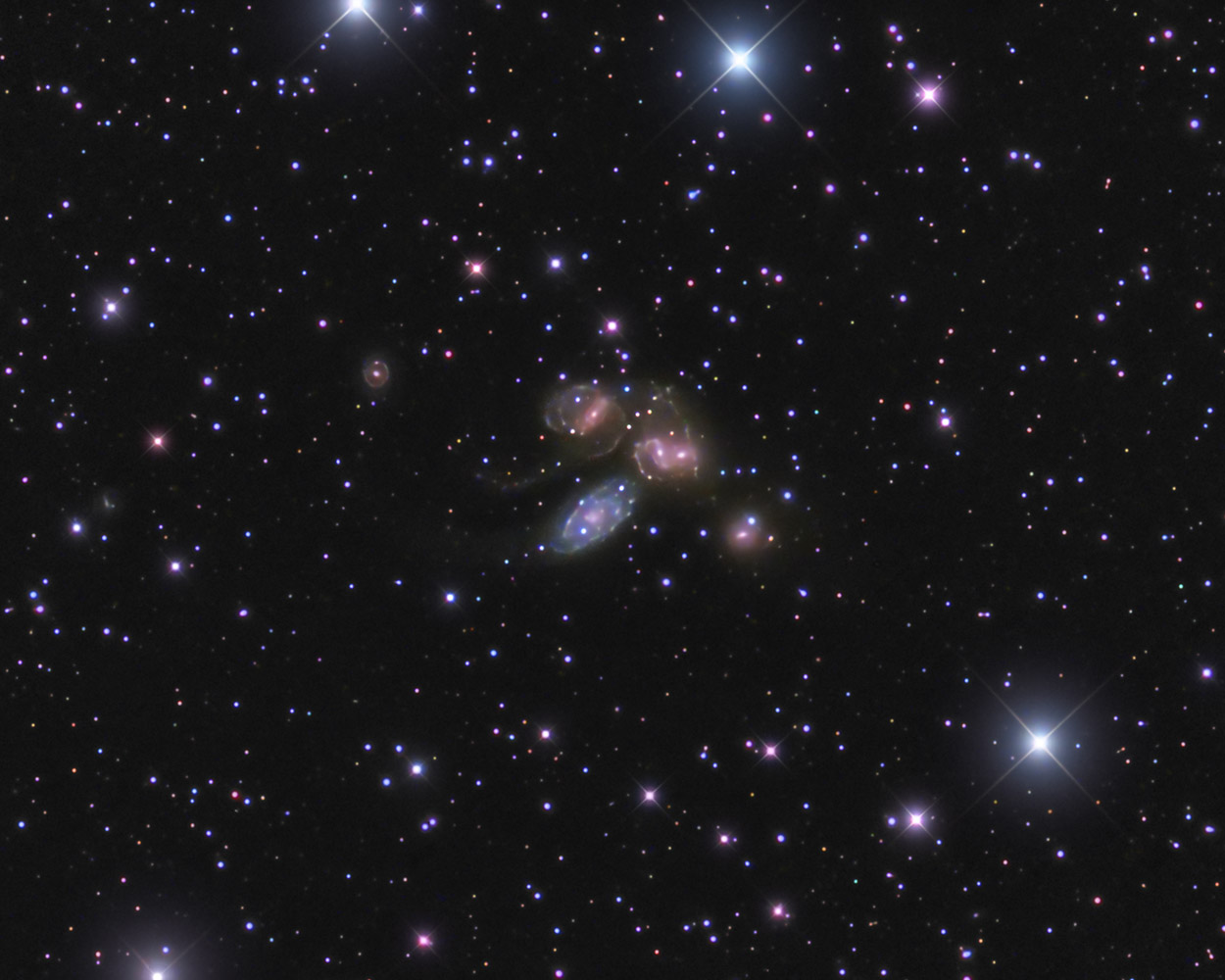 |
Abell 78
|
|
20th NOVEMBER 2016Planetary Nebula Abell 78 |
Located in Cygnus. Abell 78 is one the rare class of "born again" planetary nebulae. This object was studied by ESA using their XMM-Newton X-ray space based obseravtory. The following is from the subsequent research paper by J.A. Toalá et al. 2015:- "Although nuclear burning of hydrogen and helium had ceased in the core of the dying star, causing it to collapse under its own weight and its envelope to expand into a bubble, some of the star’s outer layers became so dense that fusion of helium resumed there. The renewed nuclear activity triggered another, much faster wind, blowing more material away. The interplay between old and new outflows has shaped the cloud’s complex structure, including the radial filaments that can be seen streaming from the collapsing star at the centre." Quite a faint object but I perhaps went a bit overboard with the equivalent of 13.5 hours worth of exposures! Image Details
|
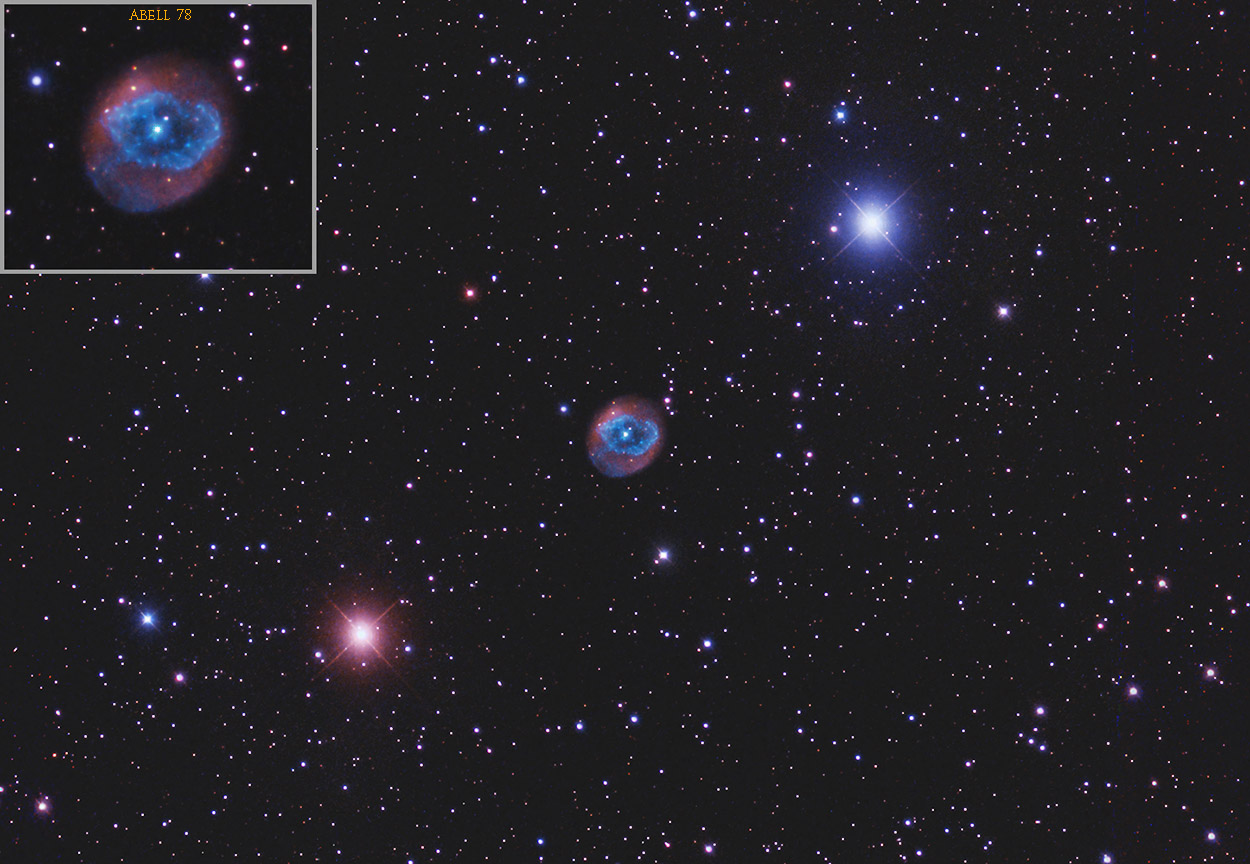 |
Abell 78
|
|
6th NOVEMBER 2016Emission Nebula Sh2-140 |
A good name for the nebula would be the Seagull Nebula but unfortunately that name has already been used for Sh2-296. The blue stars are obviously a young open star cluster in the foreground but they don't appear to have a catalogue number of their own. Galaxy Map states the following "Sh 2-140 is part of the Cepheus Bubble, the expanding shell of gas and dust surrounding the Cep OB2 association. The bright rim is created by the B0.5 V double star HD 211880 ionising a Bok globule located within the southwest side of the LDN 1204 molecular cloud". Not one of Sharpless' best objects but with a 98% full Moon then it had to be a high DEC h-alpha target. Image Details
|
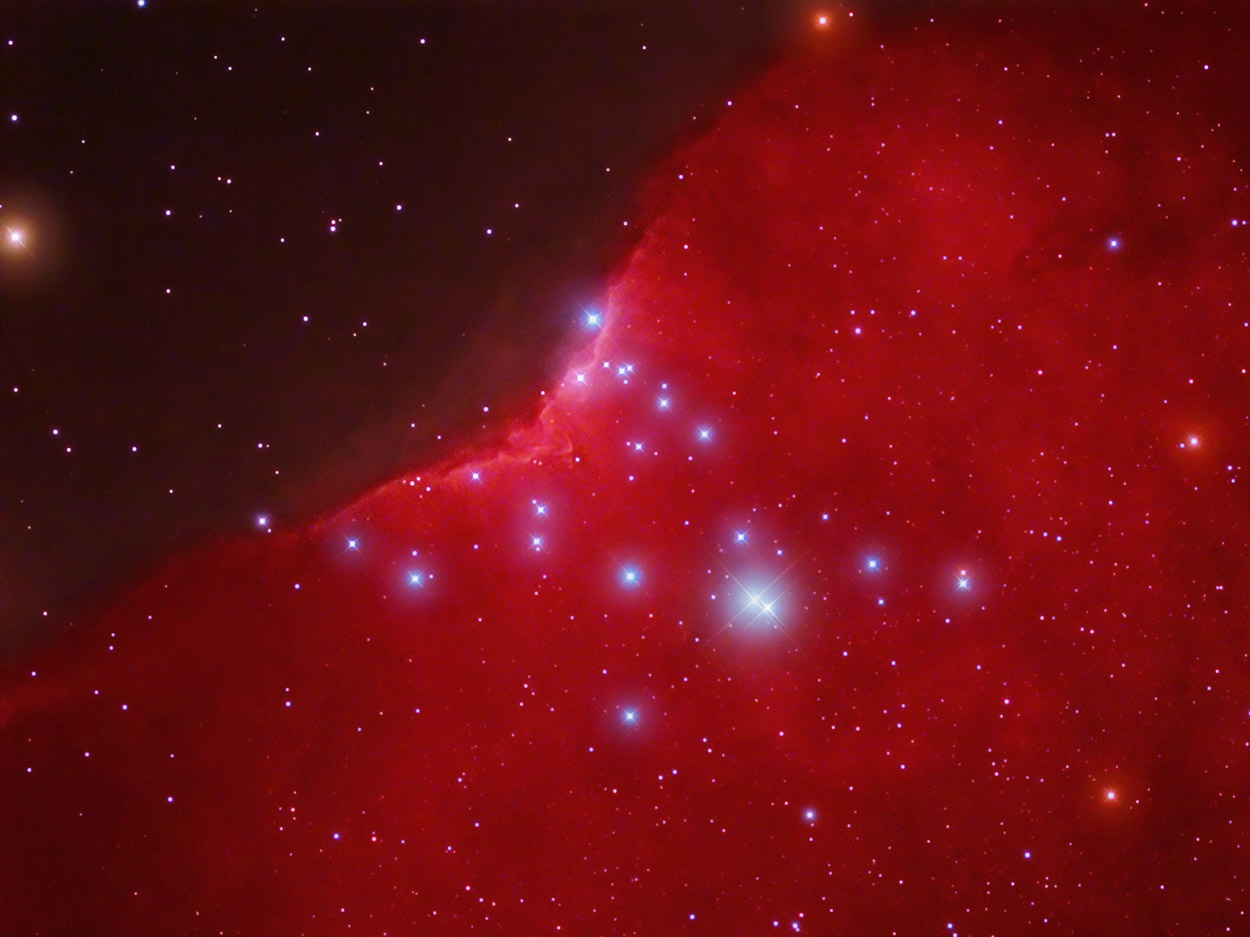 |
Sh2-140
|
|
9th OCTOBER 2016Emission Nebula Abell 71, Sh2-116 |
The central object in my image is known as Abell 71 and also Sh2-116 - for what kind of nebula it is read on. The much larger surrounding object is Sh2-115, an emission nebula. Abell71/Sh2-116 has a complicated history. This time it was Abell who mis-classified it although perhaps Perek & Kohoutek (1967) should take some of the blame as they too classed it as a planetary nebula. Abell 71 is actually an emission nebula. It does appear to have an unusual spiral pattern so was perhaps an easy mistake to make. The issue was settled as long ago as 1991 by Pismis at al. in "A comparative study of the Morphology and Velocity Field of the Emission Nebula S153, S207, S212, and A71". This was based on its similarities to Sh2-153 (S153) and Sh2-207 (S207) plus the fact there was virtually no OIII emission present - a standard feature of planetary nebulae. Image Details
|
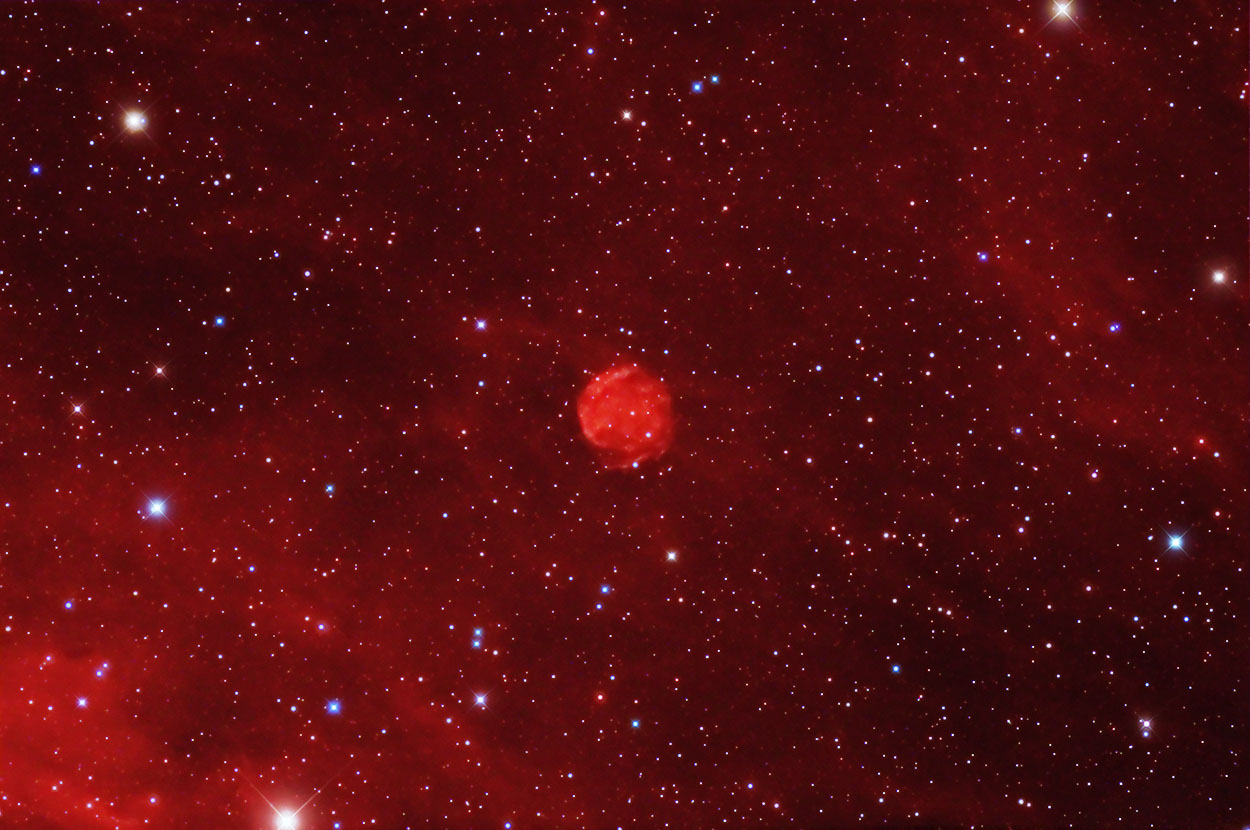 |
Abell 71 & Sh2-115,116
|
|
25th SEPTEMBER 2016Planetary Nebula NGC 6842, Sh2-95 |
What was Stewart Sharpless thinking about when he included this object in his catalogue of (red) emission nebula? It is not an emission nebula and it is definitely not red. Virtually the only background information I could find was from the Kopernik Observatory & Science Center: "NGC 6842 was discovered in 1919 by Curtis. In has a faint 14th magnitude irregular disk with traces of ring structure. The central star is magnitude 16.2, and the nebula is about 50 arc seconds in diameter". Not sure about that ring structure though - more like a helix? Its distance is around 4000 light year according to Phillips (2004): Planetary nebula distances re-examined: an improved statistical scale. Located in Vulpecula Image Details
|
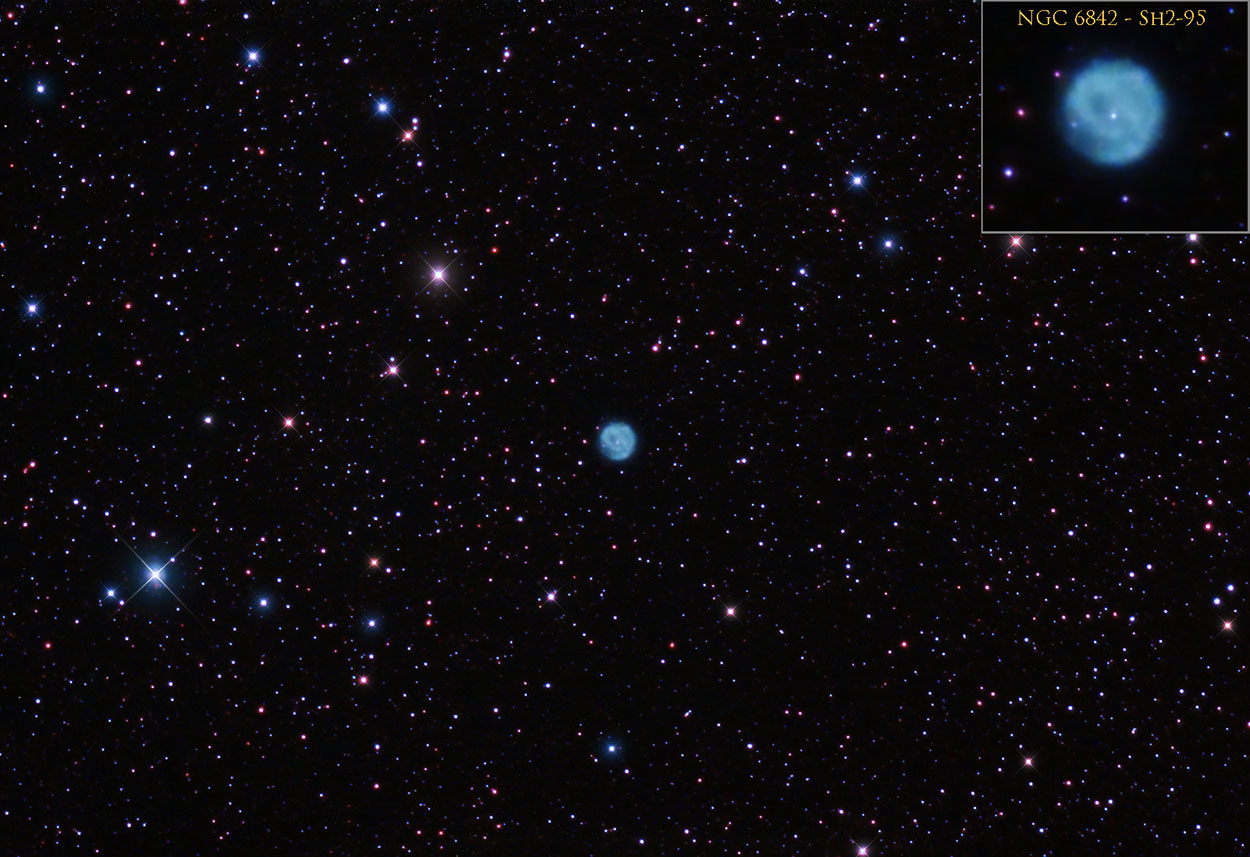 |
Sh2-95 - NGC 6842
|
|
15th SEPTEMBER 2016A Ring Nebula in Lyra - Minkowski 1-64 (PK 64+15.1) |
This is the "other" ring nebula in Lyra - a little less famous than M57. It is a lot lot smaller too at 1/10th the size - it is only 18 arcseconds across whereas M57 is 180 arcseconds wide. It is located to the north of M57 and just about dead centre of Lyra. It responds well to both H-alpha and OIII. Rudolph Minkowski was a specialist in spectroscopy and worked on supernovae but in the 1940s he created a catalogue of around 200 planetary nebulae. These were not discovered with the 48 inch Palomar Schmidt telscope as might be expected but ones he had identified with the 60-inch & 100-inch telescopes at Mount Wilson. This gives a clue that they are generally very small. Image Details
|
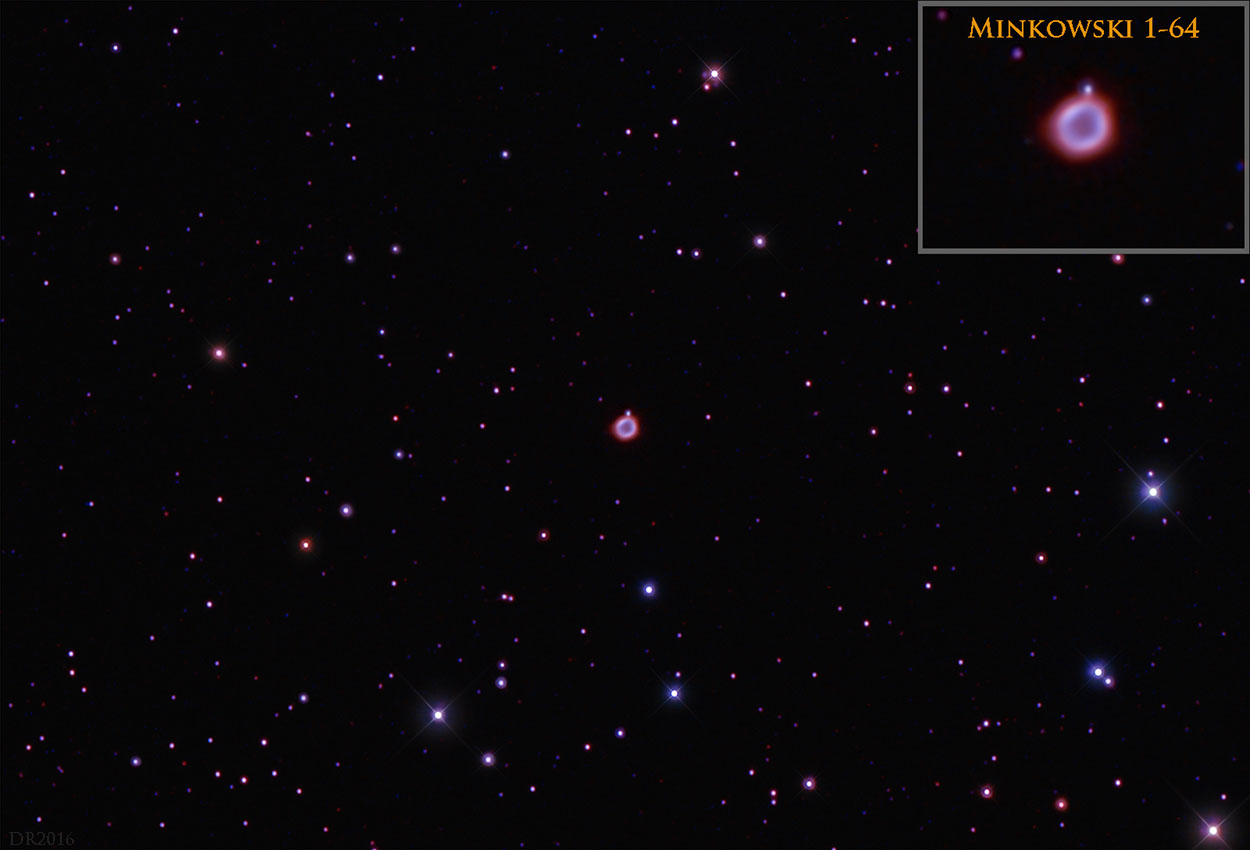 |
Minkowski 1-64
|
31st AUGUST 2016Mars, Saturn & Antares - 14th August 2016 |
|
Although low down this was too good a conjunction to miss. Foreground is Rivington, Lancashire - the ruins in the Japanese Gardens. Image Details
|
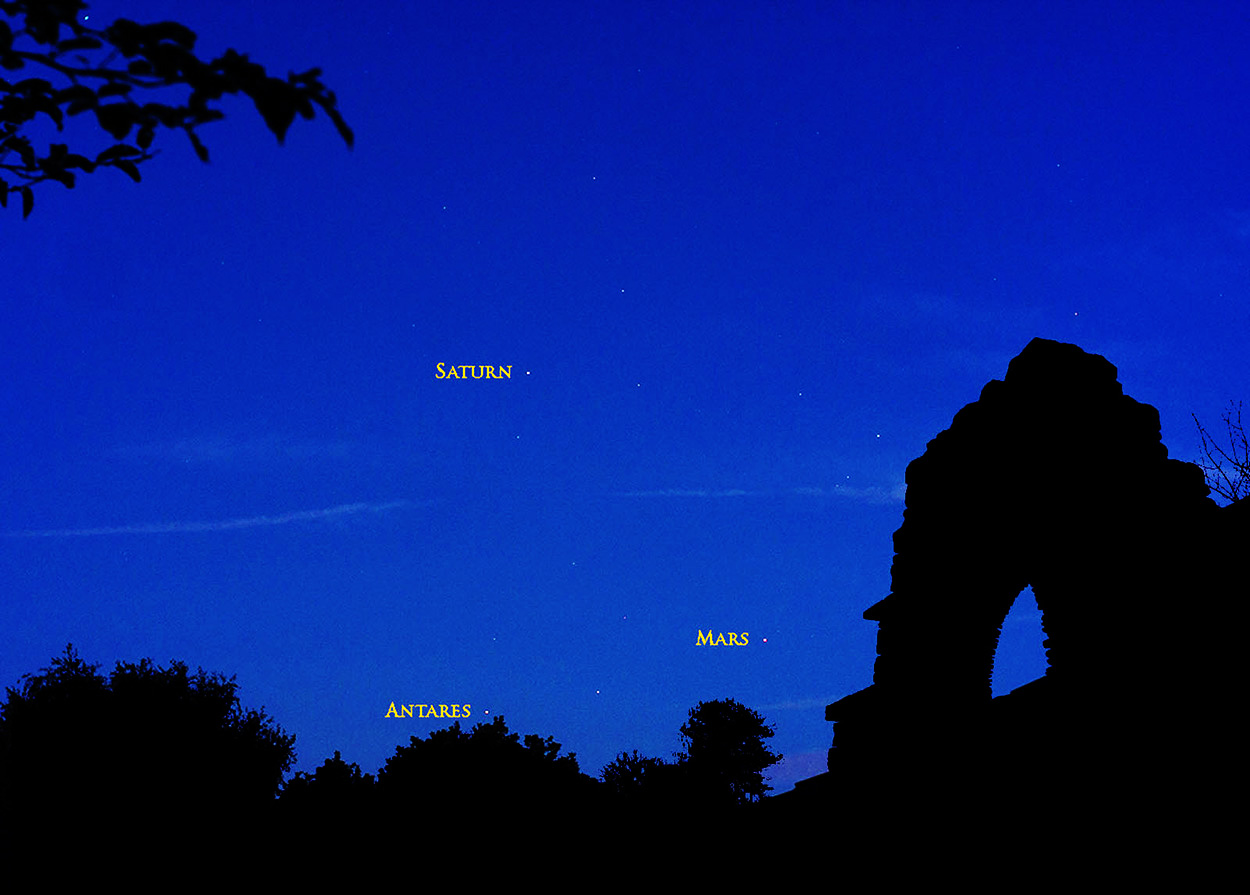 |
Mars, Saturn and Antares Conjunction 2016
|
4th AUGUST 2016Saturn - altitude only 15.5 degrees |
|
The usual summer weather meant a long wait before a clear night came along for me to image Saturn. Fainter than Mars so 10 frames per second was as fast as I could go but the seeing was much btter than when I attempted Mars. Again the homemade ADC unit was used with a separation of 45mm. Image Details
|
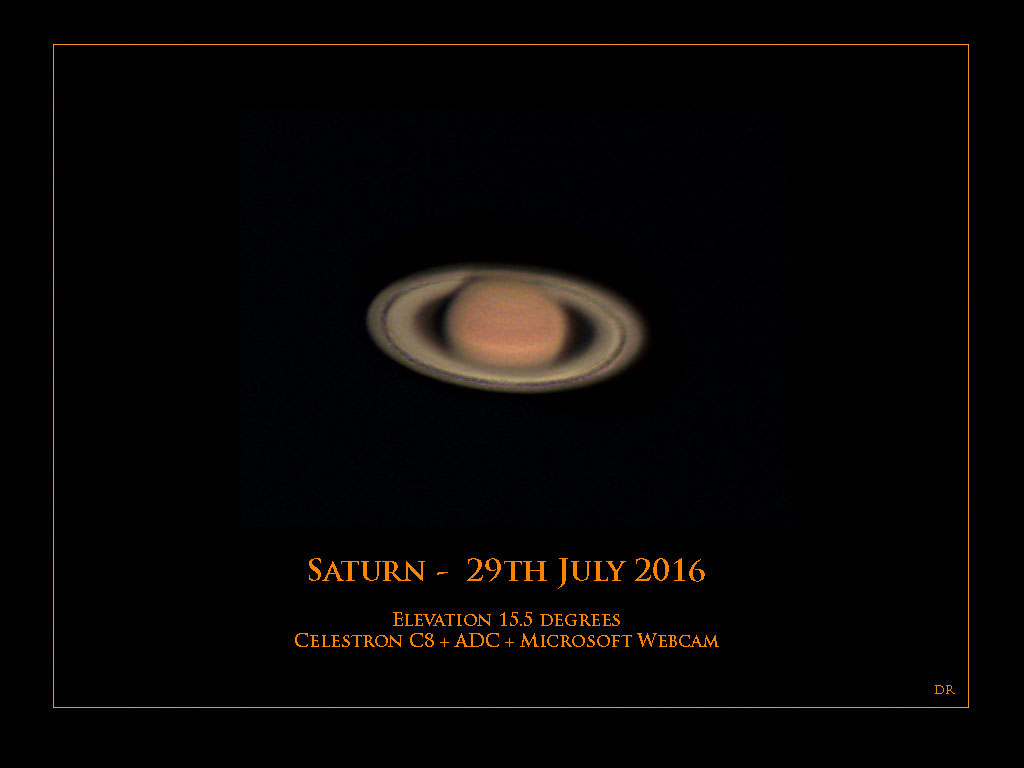 |
| Saturn at 15.5 degress altitude
|
|
24th JULY 2016Bode's Galaxy, M81 |
Is it possible to image Arp's loop from light polluted Lancashire? I wanted to find out and after 6 hours worth of exposures over 3 nights then answer was just about yes. Because of it size I had to resort to a mosaic to fit it all in and even then I could have done with a bit more sky coverage. Arp's Loop is at the top (north) of my image and left of centre. M81 is not alone and is the largest galaxy in its group which also includes M82 (NGC3034), NGC3077 and NGC2976. The group has certainly undergone interactions in the past and Holmberg IX - left (east) of M81 - is left over debris from one such interaction. In 1965 Halton Arp detected this loop on plates taken with the 48-inch Schmidt on Mount Palomar. Initially it was thought Arp’s loop was a tail resulting from the tidal interaction between M81 and M82 . However, this region of the sky is known to be filled with galactic cirrus and Arp’s loop does exhibit properties similar to those observed in galactic cirrus clouds. So perhaps on balance it is more likely part of the Milky Way and not associated with M81 after all. Image Details
|
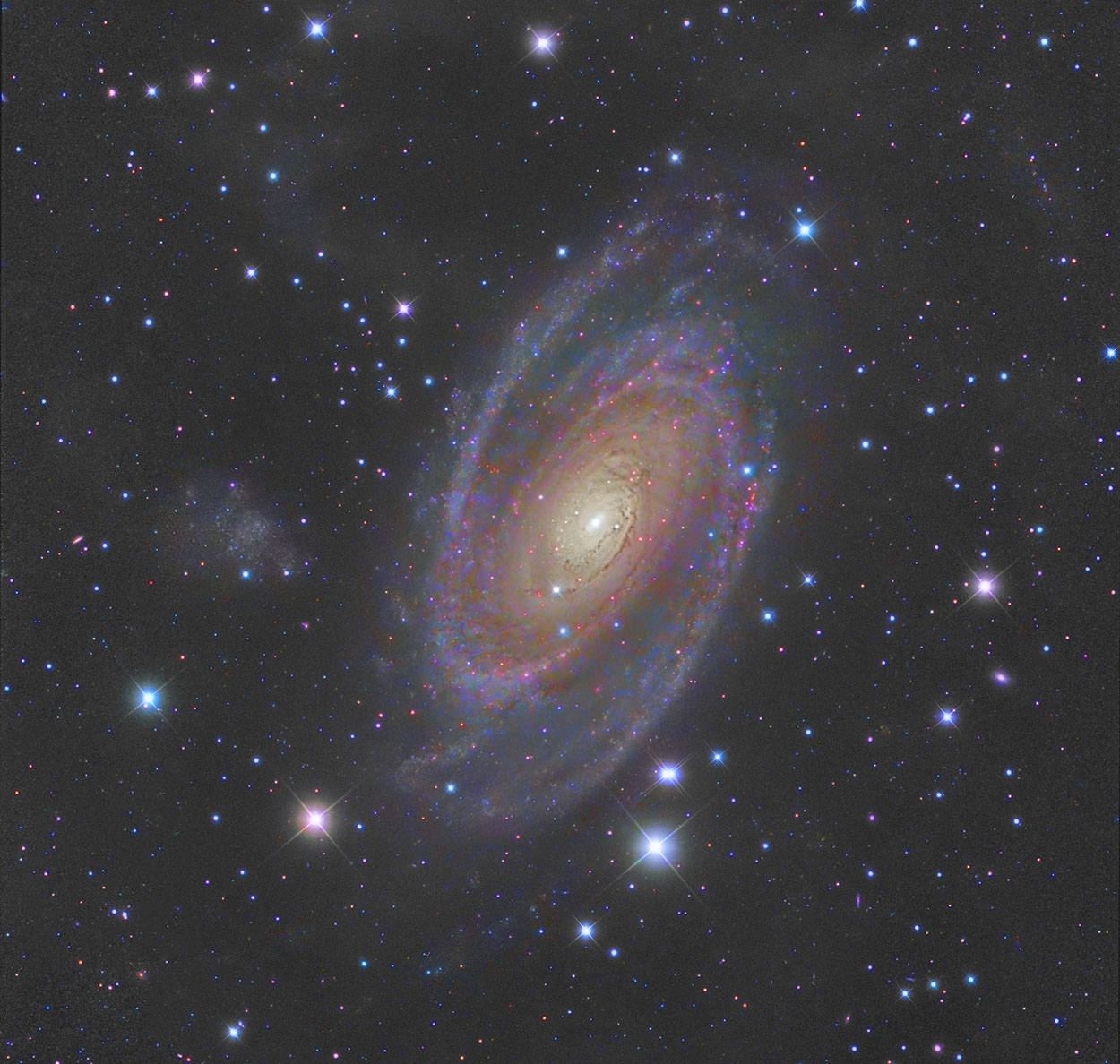 |
M81
|
26th JUNE 2016Keenan's System (Arp 104) |
This intriguing system was discovered by Keenan in 1935 and then forgotten about until rediscovered in the 1950s and entered in Arp's Atlas of Peculiar Galaxies as number 104. Note many web sites featuring this object, including Wiki and APOD, have the distance hugely wrong and some have also mixed up the galaxies catalogue numbers showing they have blindly copied each other's errors! To put the record straight:- Distance is c. 135 million light years (42Mpc) Southern galaxy (left in my image) is NGC 5216 - an elliptical Northern galaxy (right in my image) is NGC 5218 - disturbed spiral possibly barred but see later. Probably the best source of information on this pair is by Gallagher & Parker: Optical Structure and Evolution of the Arp 104 Interacting Galaxy System (Astro-ph 2010). Their conclusion is that the pair are now separating after a close passage 300 million years ago and the bridge is stars dragged out from the outskirts of NGC 5218. They also favoured NGC 5218 being itself the result of an earlier minor merger. The system's eventual fate, they concluded, was likely to be a single galaxy although its type would depend on how much gas was remaining at that time. Image Details
|
|
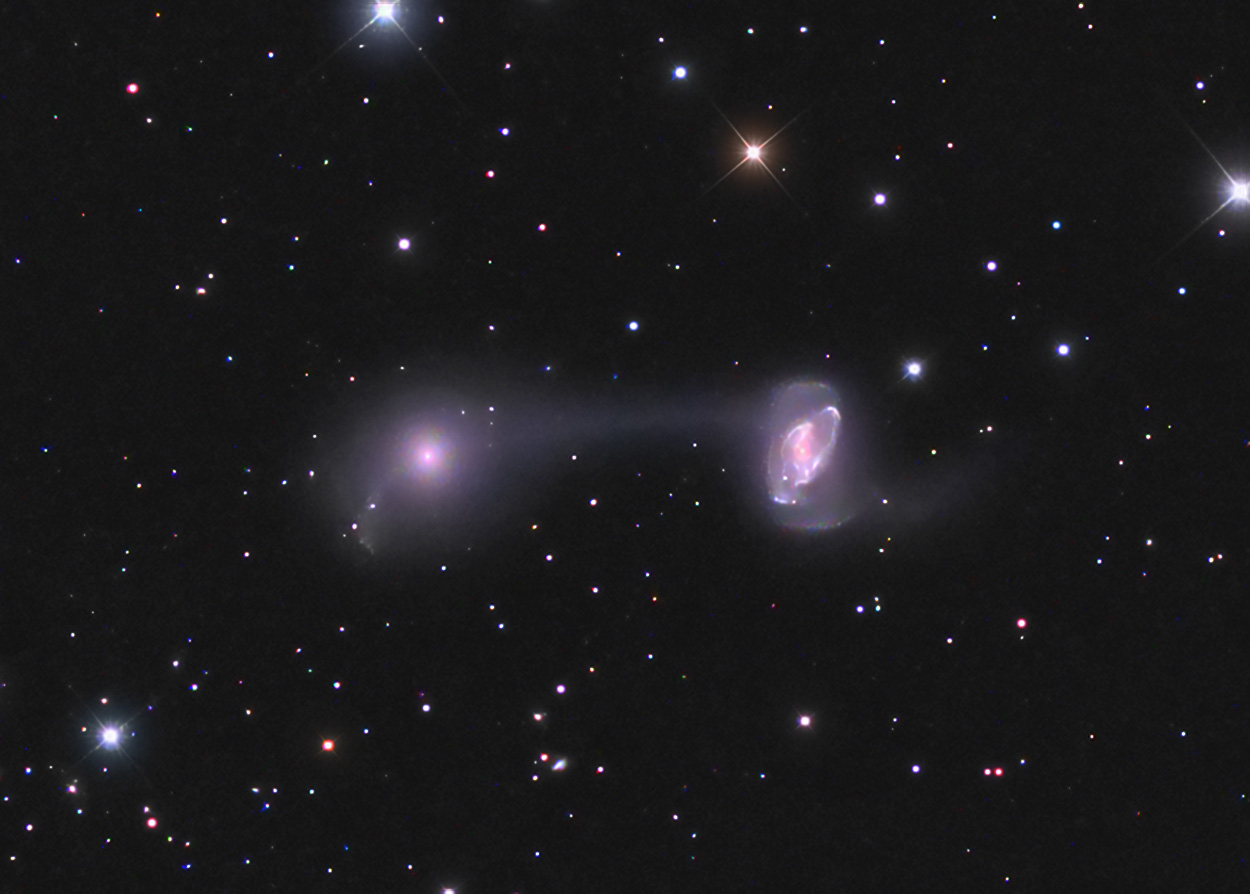 |
Keenan's System
|
12th JUNE 2016Galaxy NGC 3079 & the Gravitational Lens Quasar (QSO 0957+561 A/B) |
In 1972, the Lovell Telescope at Jodrell Bank in a systematic survey discovered 800 radio sources. Follow up visual observation in 1979 by Walsh et al. identified this one as being double. Both had similar spectra and redshifts and they proposed that this was infact the same quasar being observed twice via a gravitational lens. One of the predictions of Einstein's Theory of General Relativity is that a massive object will distort the space around it forming what is called a Gravitational Lens. This causes light and radio waves from an object behind it to follow curved paths in its vicinity, producing multiple or distorted images of the same object. The massive object doing the bending in this case is a galaxy cluster. Subsequent research has confirmed this as correct. The quasar images are 6 arcseconds apart and are magnitude 16.7 but they do vary. These variations observed over 30 years have shown that image A of the quasar reaches earth about 417 days earlier than the corresponding image B. Their separation of 6 arcseconds and light path diffrence of 417 light days has enabled an independent geometric check on their distance to be calculated. The redshift derived distance and this geometric distance agree. This was one of the results that confirmed the immense distance of quasars and that their redshifts are real. North is to the right in my image. Image Details
|
Note the jets from image A are not seen in image B. This is because the precise alignment necesaary for lensing is only correct for the quasar itself. |
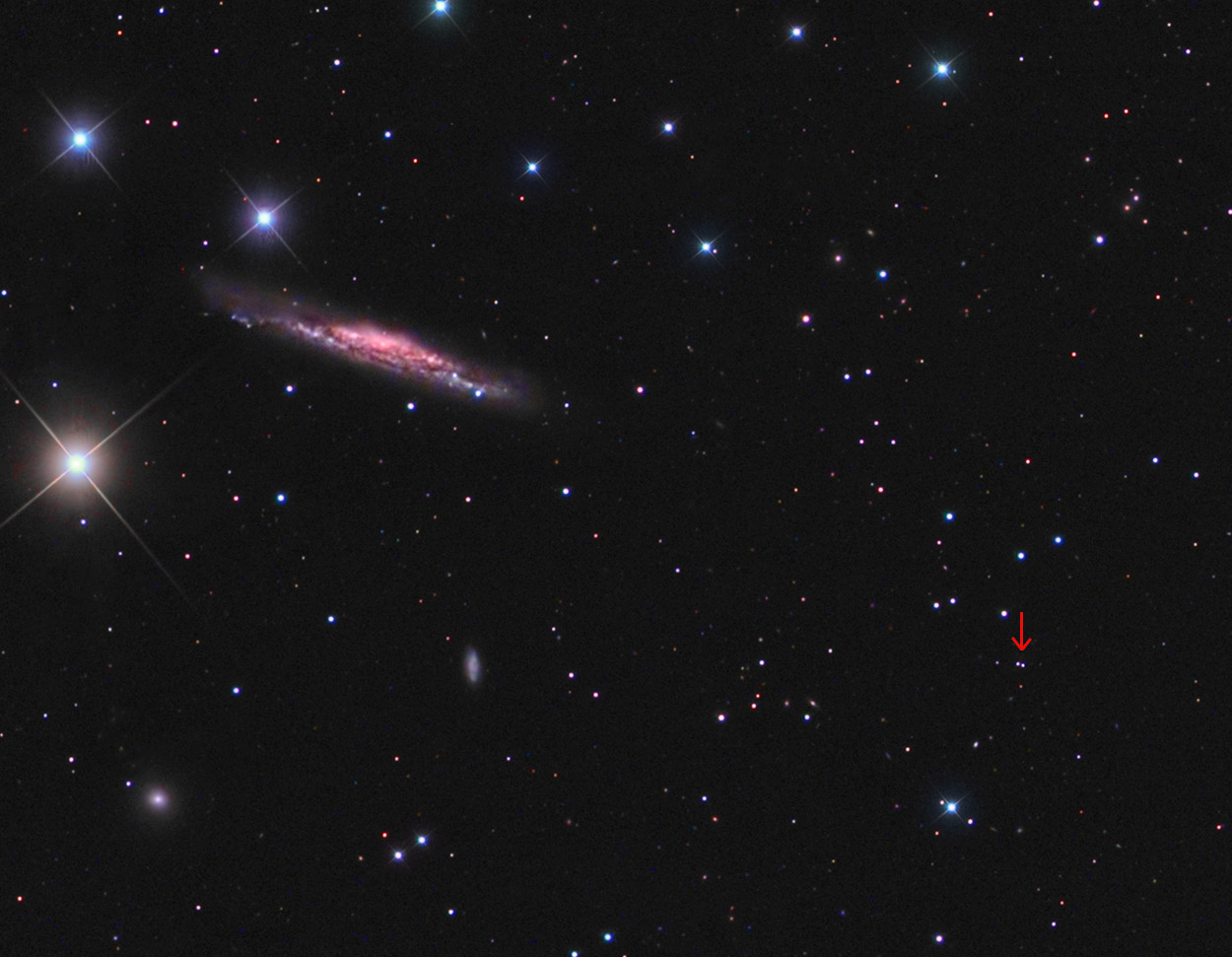 |
Gravitational Lens Quasar
|
5th JUNE 2016Mars - altitude only 13 degrees |
|
The ultimate test of my ADC unit on Mars at an altitude of only 13 degrees. Sure the dispersion was brilliantly cancelled out but the turbulence at this low elevation was incredible. I was surpised the resulting image was reasonably round - some features being discernible was an unexpected bonus. The simulation is from the Astronomy Now Mars Mapper. It shows a north polar cap but my guess is had melted by the time I took this image. Not a winner but it was good fun trying get anything at this height when shooting straight over the top of Manchester. Image Details
|
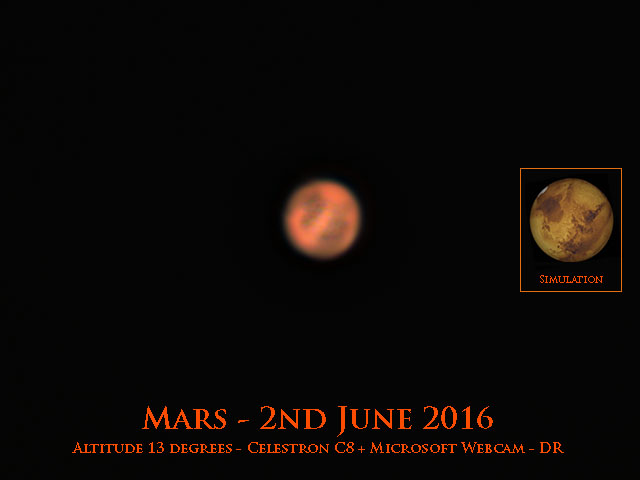 |
| Mars at 13 degress altitude
|
22nd MAY 2016Edge-on Galaxy, IC 2233 |
IC 2233 is one of the flattest galaxies known. It is a prime example of a super-thin galaxy, where the galaxy’s diameter is at least ten times larger than the thickness. IC 2233 is actually a bulgeless Sd galaxy located at a distance of around 33 million light years. However, IC 2233 is much more complex than it looks. Matthews & Uson (2008) discovered a regular corrugation pattern in the H i disk. They meaured the vertical structure of this galaxy at several additional wavelengths, ranging from the far-ultraviolet to the far-infrared. they found the corrugations were prominent in Population I stars, including the young to intermediate-age stars, the H ii regions, and the dust. However, the vertical displacements become less pronounced in the older stellar populations traced by the mid-infrared light. They suggested that the process leading to the vertical displacements may be linked with the regulation of star formation in the galaxy. This galaxy was discovered by pioneer British astro-photographer Isaac Roberts in 1894. He was president of Liverpool Astronomical Society and had an observatory in Birkenhead. He is most famous for his photograph of M31 - the first to fully reveal its true form and extent. Image Details
|
|
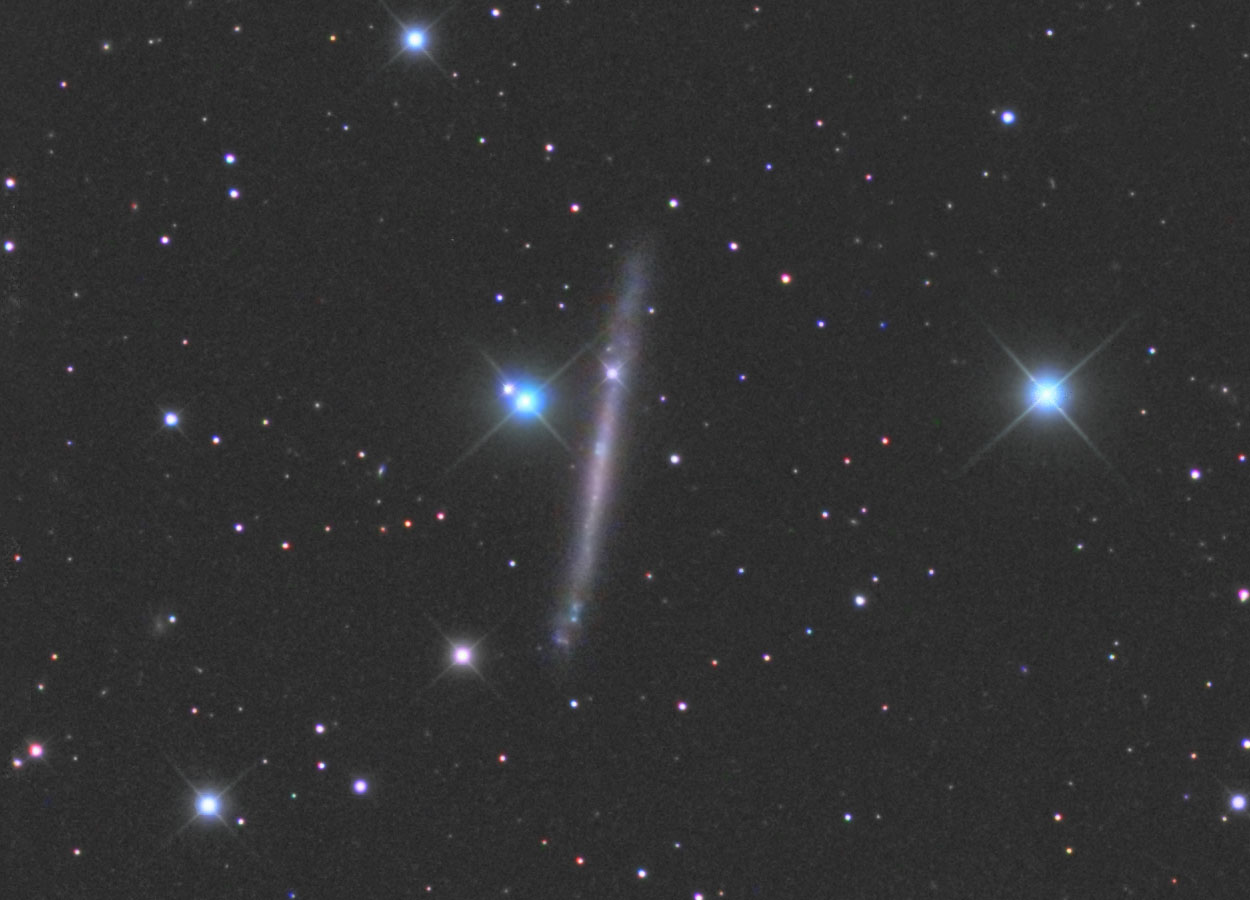 |
IC 2233
|
13th MAY 2016Transit of Mercury 2016 |
Would you believe it - it turned out Lancashire was one of the best places on Earth to see the transit of Mercury! Our society observed the start and middle phase at Bolton School but there was time to get home and set up for a final view. This was the last view of it from my back garden before it disappeared behind trees. Image Details
|
|
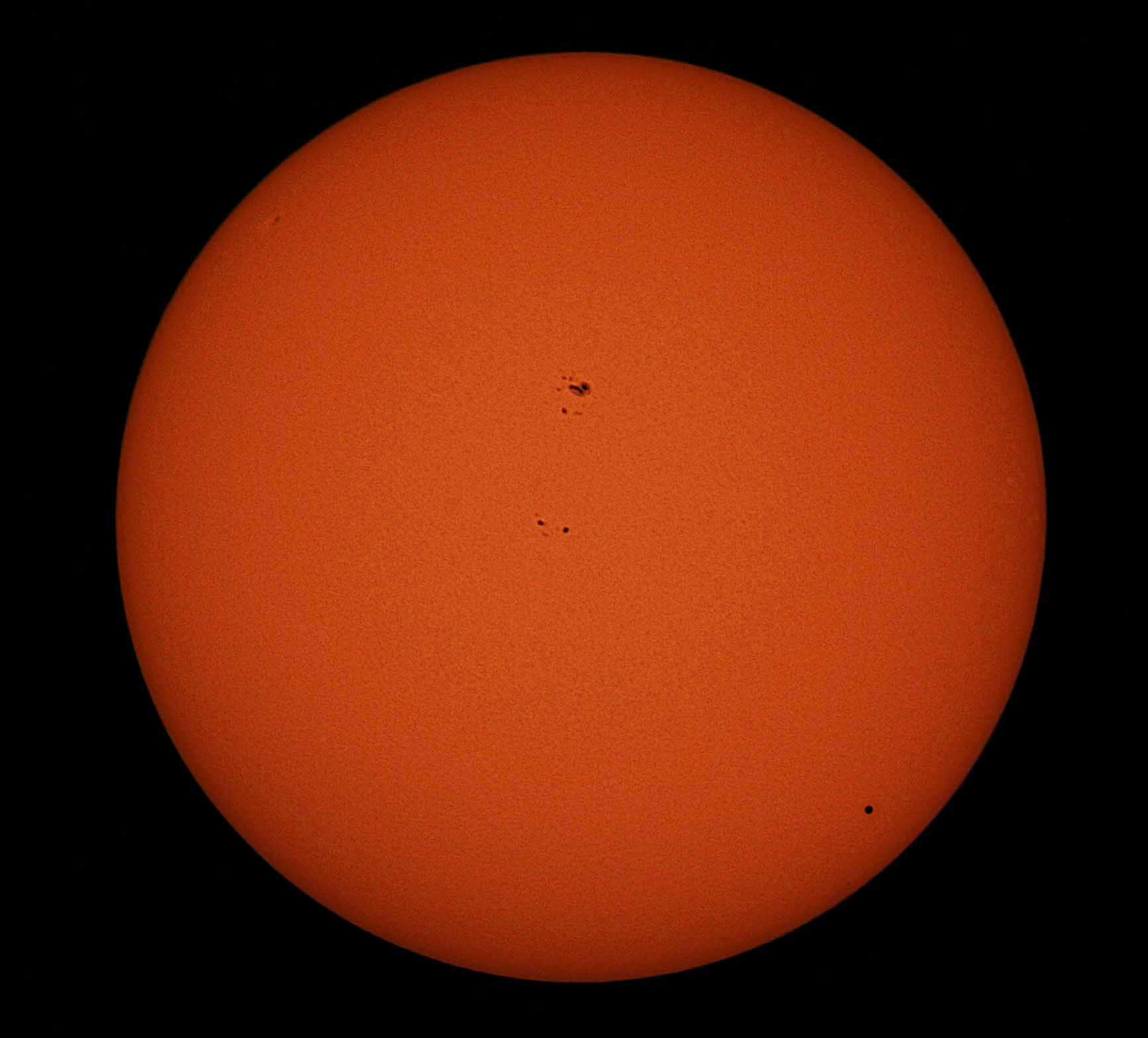 |
Mercury Transit 2016
|
5th MAY 2016The Bear's Paw Galaxy, Arp 6 |
The first entry in Arp's Catalogue of Peculiar Galaxies that looks peculiar! It is generally classed as a BCD - Blue Compact Dwarf - and as such comprises a elliptical/spherical halo with several very bright star forming knots. However, the NASA NED database classes it as a barred spiral and there does seem to be perhaps a barred spiral lurking behind the start burst knots. Also known as Markarian 86 (he liked blue objects) but more commonly known as NGC 2537. Located in Lynx and it is at a distance of around 25 million light years. The small (spiral?) galaxy to the left is NGC 2537A but is an unrelated background object. Image Details
|
|
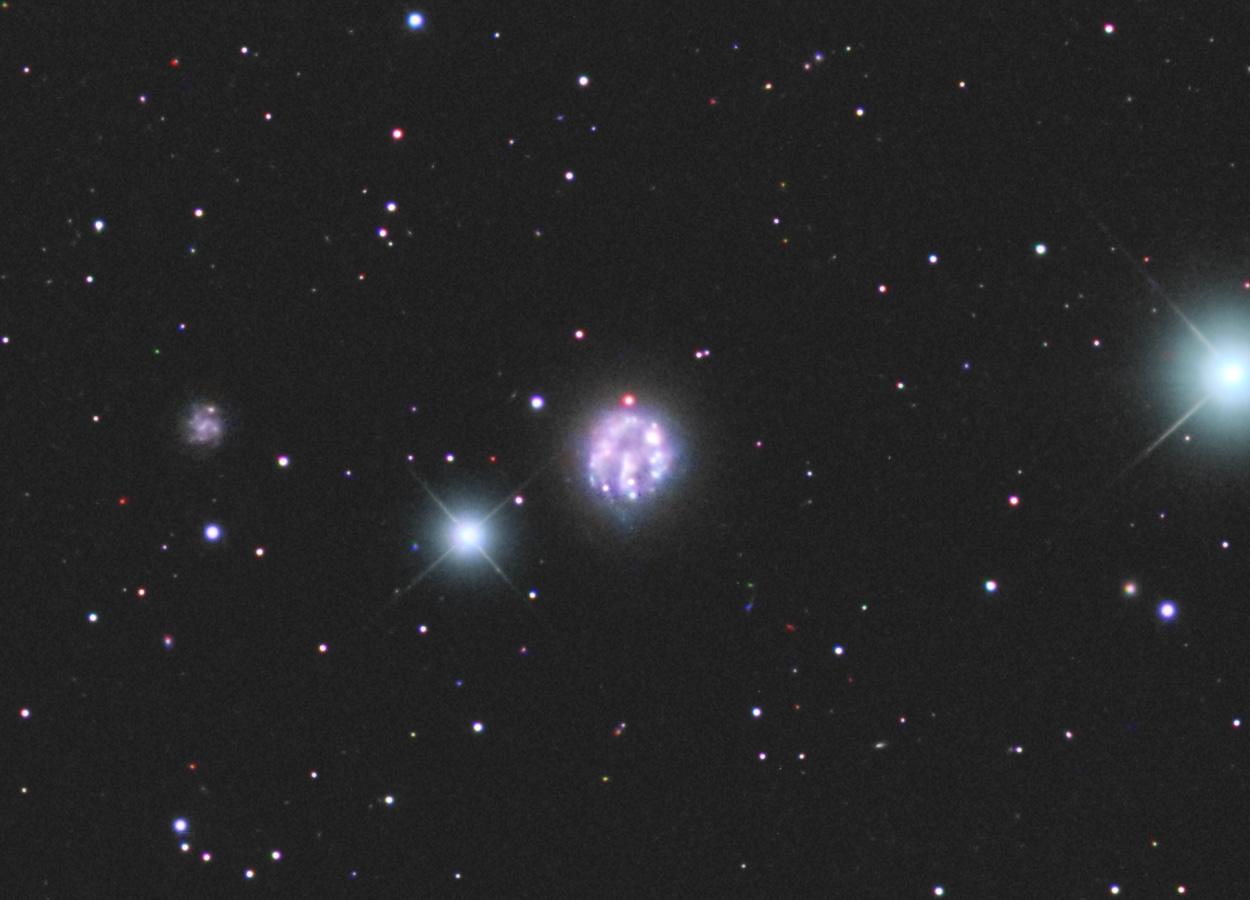 |
The Bear's Paw Galaxy
|
20th APRIL 2016The Seahorse Nebula (Sharpless Sh2-249) |
The "Seahorse" is part of the very large nebula Sh2-249 (IC444). It is located to the north east of the supernova remnant IC443 (Sh2-248) and the association or otherwise of these two nebula is the subject of some debate. Probably the definitive paper was by Robert Fesen way back in 1984. He produced evidence that the supernova was indeed interacting with the edge of Sh2-249 thus placing them at the same distance. Yet in the same year, Donati-Falchi & Tafani concluded the exact opposite - Sh2-248 and Sh2-249 were not adjacent and interacting. What is generally agreed is that Sh2-249 is energised by stars in the Gemini OB1 association Image Details
|
|
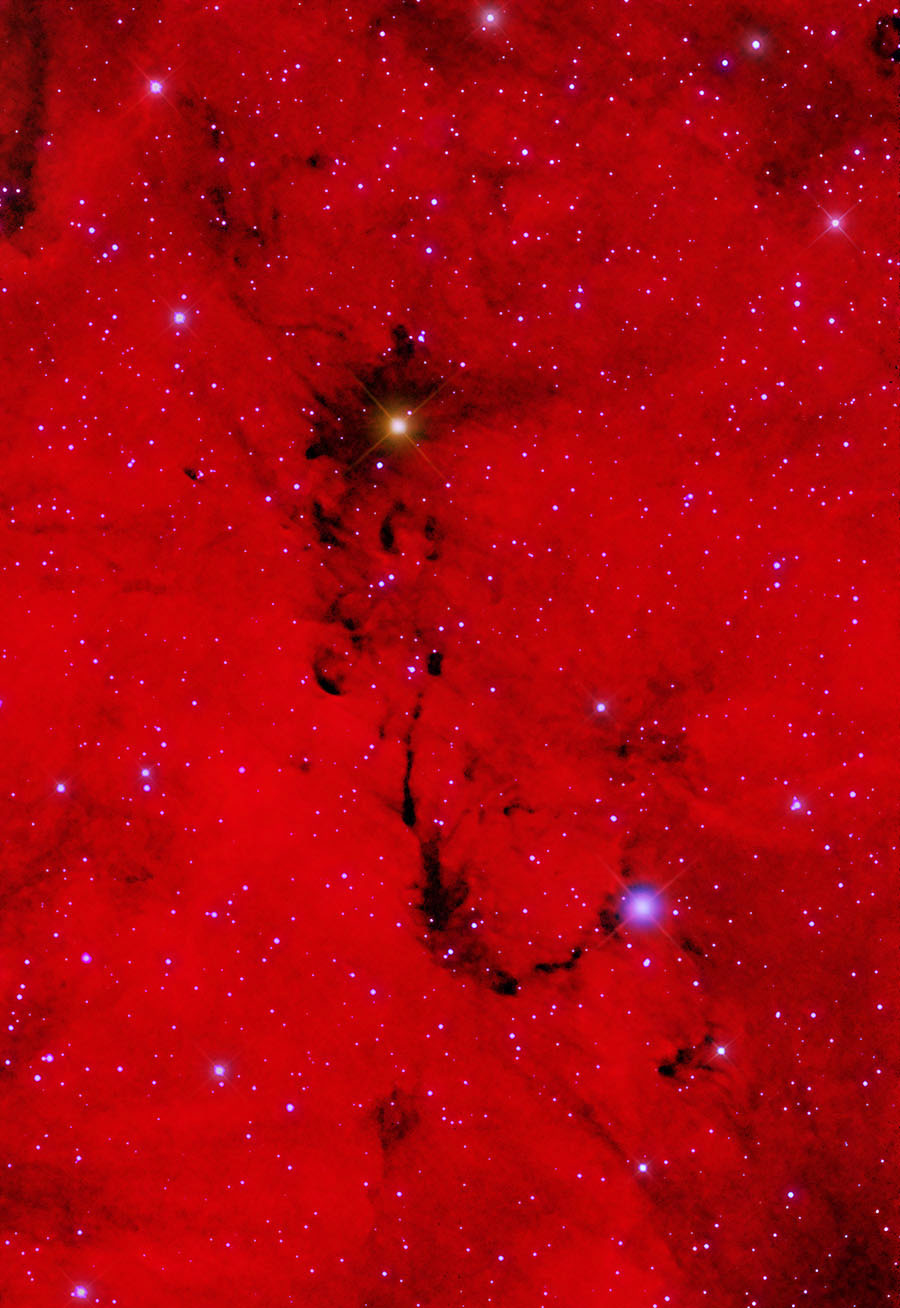 |
The Seahorse Nebula
|
13th APRIL 2016Jupiter - altitude 40 degrees |
|
First test of my ADC unit on Jupiter at an altitude of 40 degrees. This altitude is probably marginal as to whether the gain in resolution (no dispersion) is greater than the effect of 2 extra glass elements (prisms) in the opical train. The Microsoft Webcam was acting up though. Unbenown to me the Microsoft Lifecam software had re-installed itself. Sharpcap needs it to be removed to work properly but I didn't realise this till the next day. I need a check list as I only image the planets once or twice per year. Image Details
|
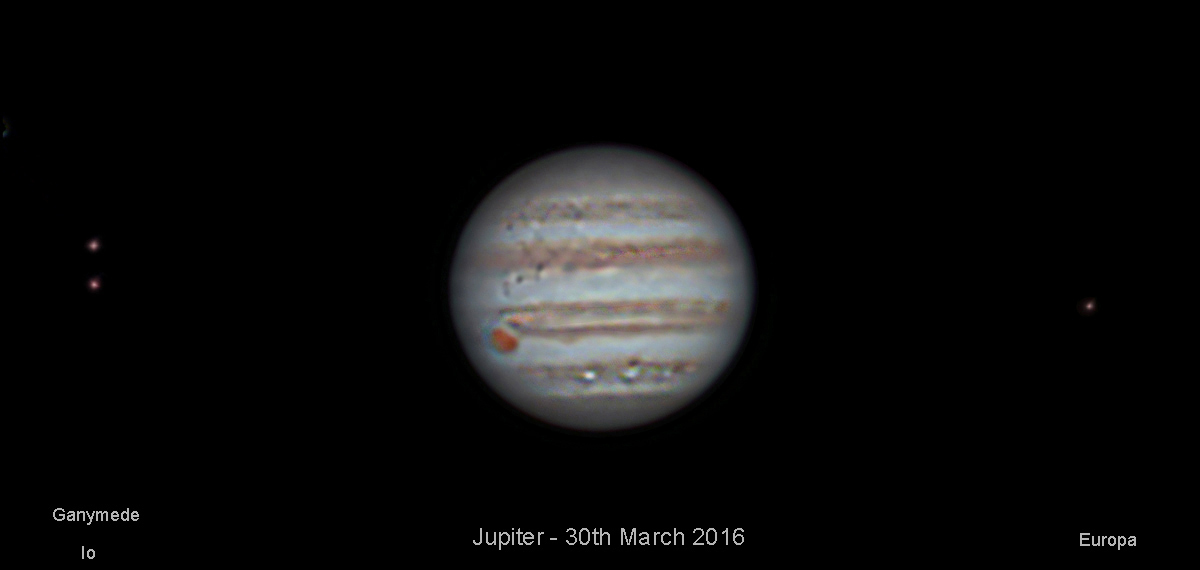 |
| Jupiter 30th
March 2016
|
15th MARCH 2016Sharpless Sh2-241 & Van den Bergh 65 |
I could not find a great deal of information about this rather forgotten Sharpless object located down at the bottom of Auriga. Just a single paper by Vallee in 1987 gives some basic information and describes it as "a blister-type HII region on the surface envelope of a molecular cloud". The latter is listed as G180.9+4.1 and is located behind Sh2-241. My image also contains the blueish reflection nebula Van den Bergh 65, which is a completely unrelated object. Wiki has some basic information and gives a distance of around 3600 light years. It is just part of a larger area of obscuring clouds. Image Details
|
|
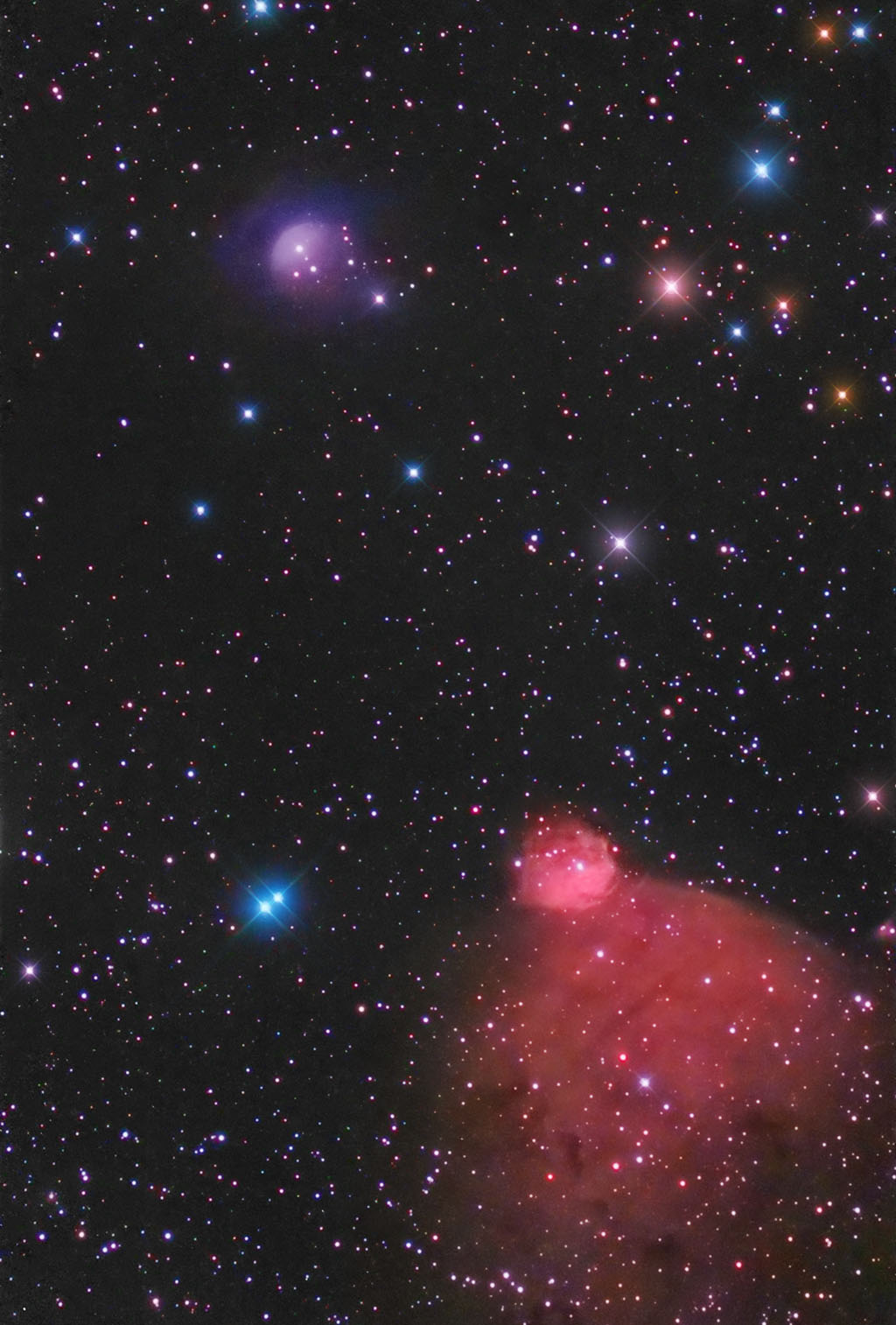 |
Sh2-241 & VdB65
|
1st MARCH 2016The Spaghetti Nebula, Simeis147 |
This very faint supernova remnant in Taurus is big - about 6 full Moons wide i.e. 3 degrees. It's distance is estimated at 3,000 light years and that means its real size would be around 150 light years across. It is the result of a stellar explosion that occurred 40,000 years ago which produced the nebula and left being pulsar PSR J0538+2817. The latter emits a strong radio signal discovered as part of the NRAO VLA Sky Survey. Without using mosaics, then a 200mm lens is perfect on my Canon 60D for this object. There are never enough clear nights for mosaics in Lancashire. This time I used an Astronomik 6nm H-alpha clip filter and the result was much better than the 12nm one I had used 2 years ago. It was also catalogued by Sharpless as Sh2-240. The tiny nebula at the 8 o' clock position is Sh2-242. Image Details
|
|
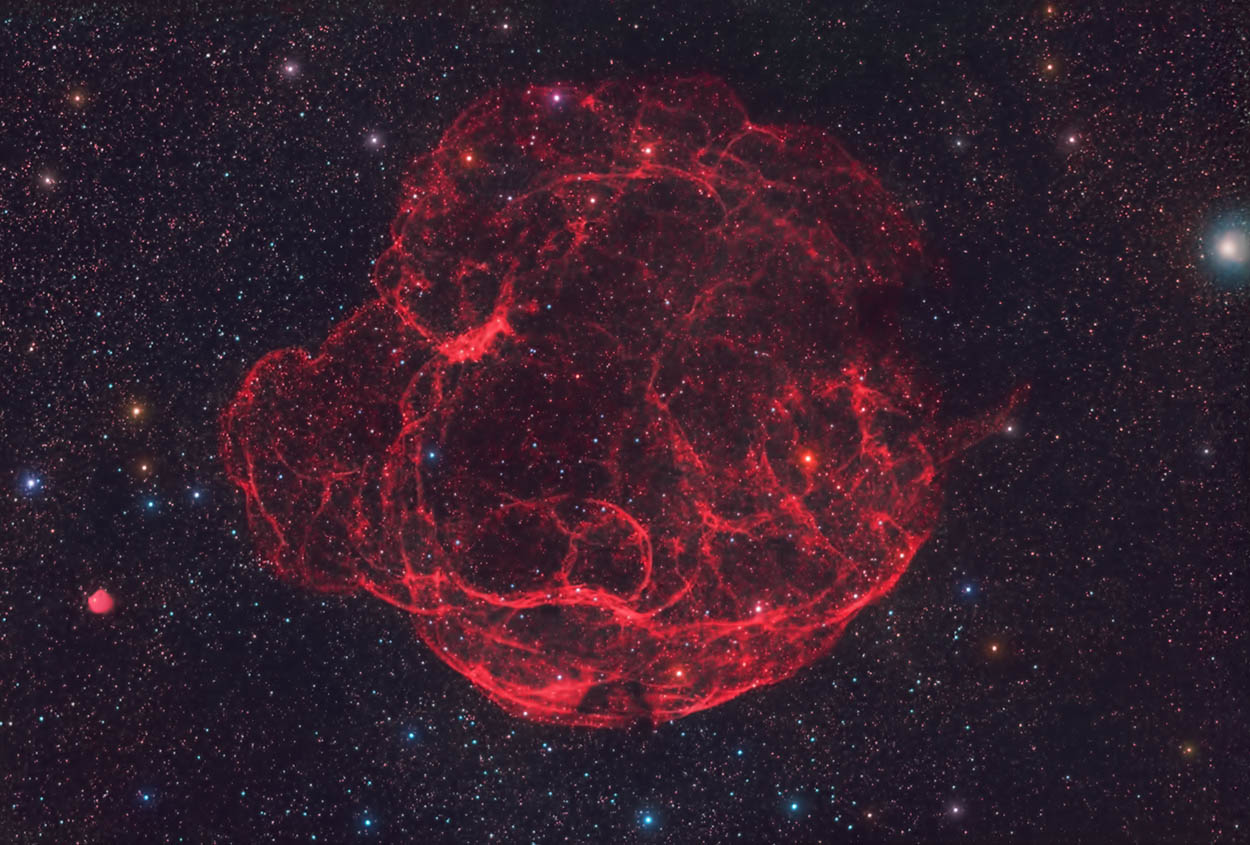 |
Simeis 147
|
14th FEBRUARY 2016The Dwingeloo Galaxies |
Part of the Maffei/IC342 group of galaxies but even fainter. Infra-red is all but essential to record these three. Dwingeloo 1 and 2 were discovered in 1994 as part of the Dwingeloo Obscured Galaxy Survey (DOGS) - Dwingeloo is a Dutch 25 metre radio telescope. These two are therefore radio galaxies. MB3 on the other hand is radio quiet so they did not detect it. It was found later by McCall and Buta when they were searching for other members of the group. Dwingeloo 1 is a classic barred spiral galaxy. Dwingeloo 2, is an irregular galaxy and largely obscured by an overlying bright star. MB 3 is surprisingly bright and thought to be a dwarf spheroidal galaxy. Image Details
|
|
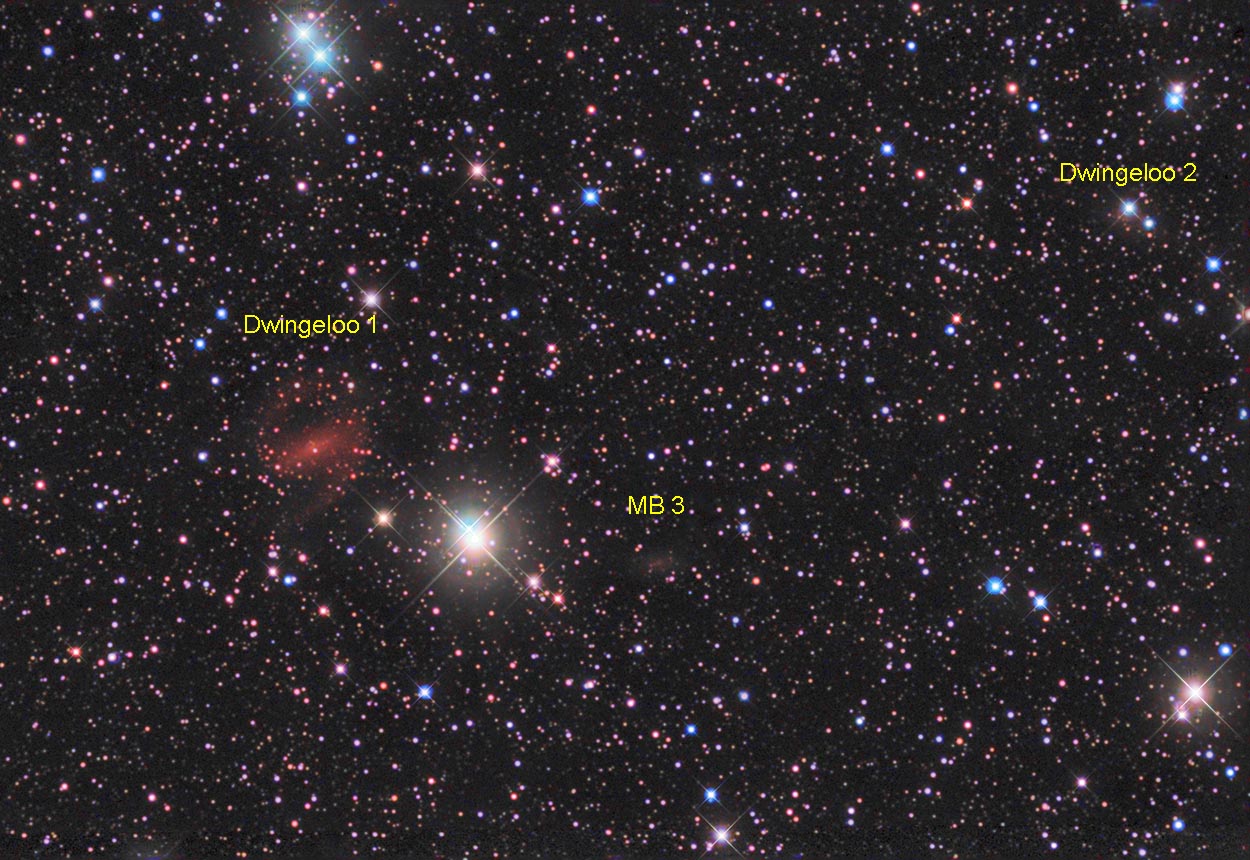 |
The Dwingeloo Galaxies
|
1st FEBRUARY 2016Barred Spiral Galaxy Maffei 2 |
About 3/4 degree further east than Maffei 1, is the barred spiral galaxy Maffei 2 - also discovered by Paulo Maffei using infra-red film. It is much fainter but is still within range of amateur telescopes. The 4-inch Tak + DSLR used for the colour information in my image had no trouble in recording it despite the DSLR being blind to the infra-red. Without the Milky Way blocking the view, this would be the best barred spiral in the northern hemisphere. Fingerhut et al. (2007) found that Maffei 2 was significantly more obscured than Maffei 1 despite being so close together on the sky. The north of the galaxy is much disturbed and looks a bit odd. Hurt et al. (1996) found that this was most likely caused by a recently merged companion galaxy and the northern feature is probably a streamer from that merger. The distances to the Maffei galaxies has always been difficult. The latest estimates are by Wu et al. (2014) placing Maffei 1 at 11 million light years and Maffei 2 at 11.5 million light years. Image Details
|
|
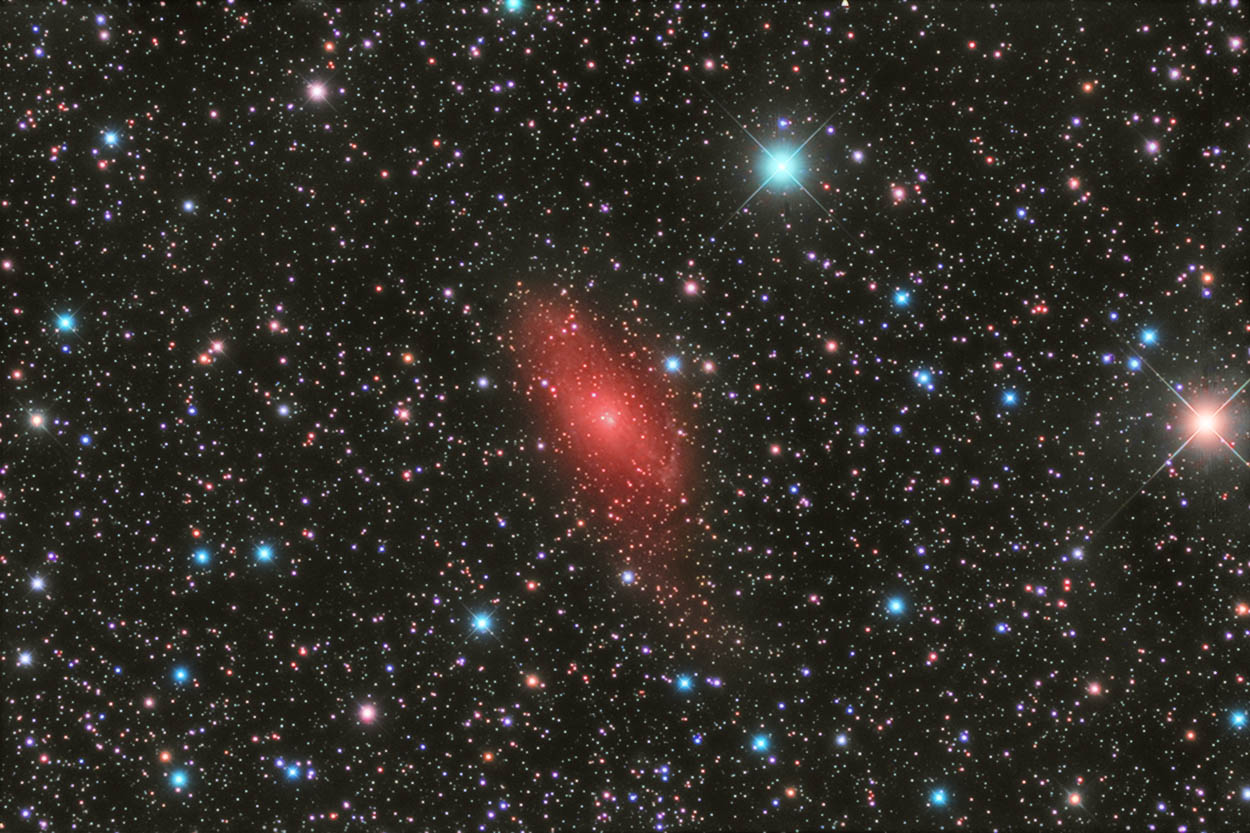 |
Maffei 2
|
17th JANUARY 2016Elliptical Galaxy Maffei 1 |
Lying close to the popular Heart and Soul Nebulae, this elliptical galaxy is often imaged but seldom recognised. Being almost directly behind the plane of the Milky Way it is heavily obscured and this has made determining its distance somewhat problematical. A good compromise figure is around 10 million light years - just beyond our local group. If it was not so obscured it would be one of the showpieces of the northern sky. It was discovered by Paulo Maffei in 1967 using Infra-red sensitive film. Although it was discovered by Paulo Maffei using infra-red film it does show up when imaged in the visible as a deep red glow. Infra-red however, does reveal its large size. To produce this image I combined visible and infra-red together so this is a somewhat false-colour image as our eyes don't see infra-red. Image Details
|
|
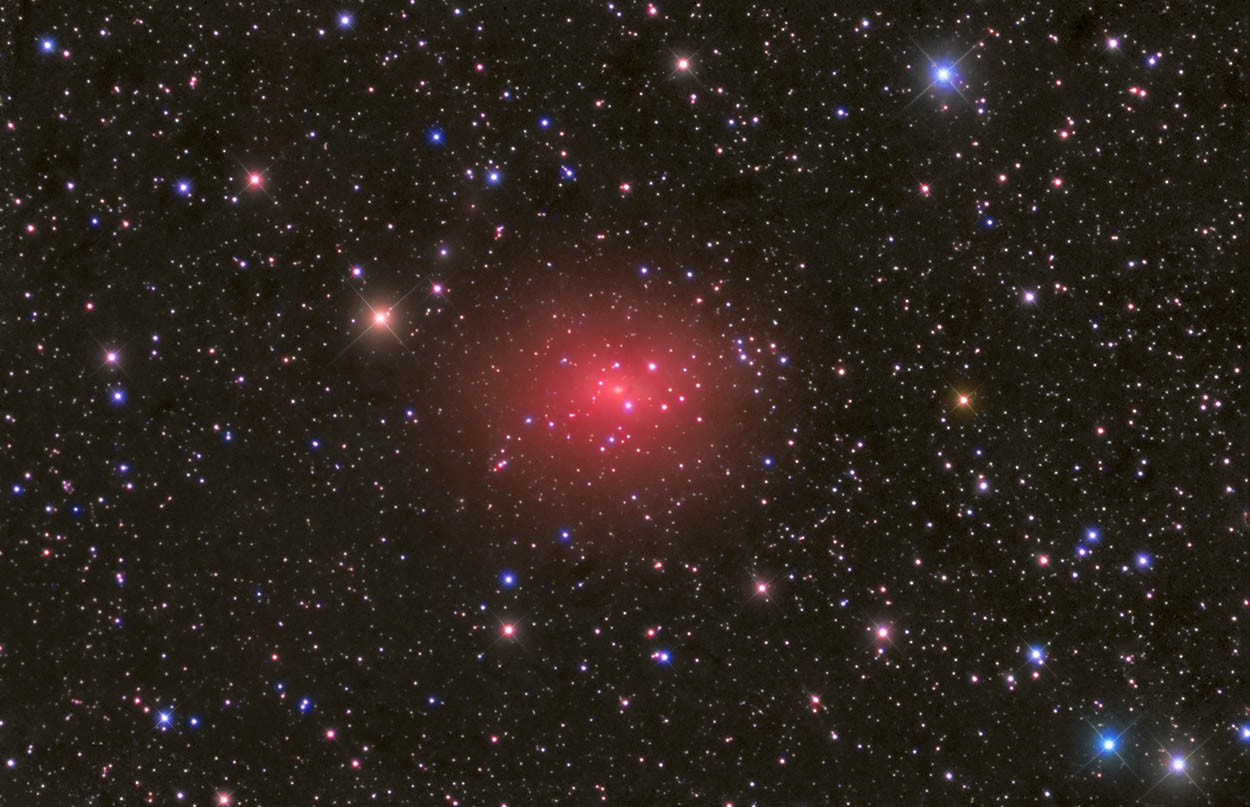 |
Maffei 1
|
3rd JANUARY 2016Globular Cluster, C39 |
Yes - a globular cluster in another galaxy. If you think this is one just for big telescopes then you are in for a shock. It is surprisingly bright at magnitude 16 given its huge distance of 2.4 million light years and is well within reach of modest refractors. It looks like a fuzzy star - don't expect to see individual stars at this range. With a larger telescope (12.5-inch) it becomes obvious it isn't a star but the cluster is not resolved. It would need the Hubble Space Telescope to see individual stars. So if you are up for the challenge of imaging a globular cluster in another galaxy then C39 is probably the best target. If you have imaged M33 before, you may have already recorded it - just check out your image - it could well be there. A globular cluster in another galaxy - in this case M33. Despite being 2.4 million light years distant it is surprisingly bright Image Details
|
|
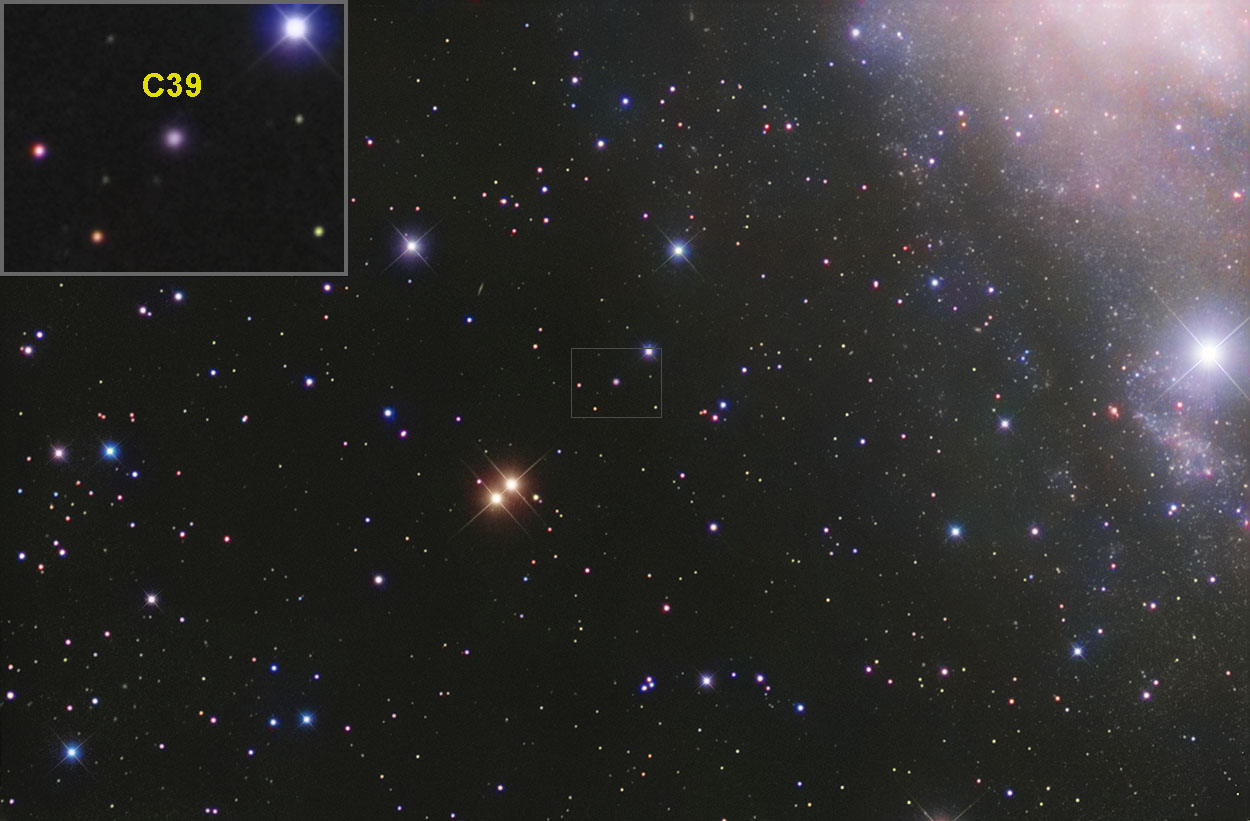 |
Globular Cluster C39
|
|
To continue with the imageBLOG for 2015 Click Here
Recommended full colour book covering all aspects of digital imaging: "Digital Astrophotography - The State of the Art" edited by David Ratledge Order Online |
Please remember these images are copyright David Ratledge. Contact me before any use is made of them.
